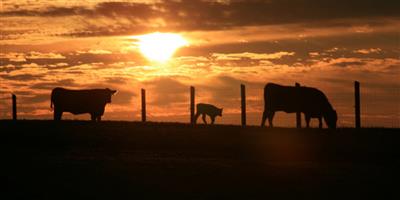written collaboratively by Shannon Sand and Heather Gessner, SDSU iGrow
The 2016 forecast of national net farm income was recently released by the USDA Economic Research Service (ERS). The ERS estimates a 3 percent decline compared to 2015 income figures. This is a potential decrease of $1.65 billion dollars in net farm income, a reduction in farm income from $56.45 billion in 2015 to $54.8 billion in 2016 (Figure 1).
If this forecast happens, then it would be the third consecutive year of declining income for the farm industry. This would represent the lowest income since 2002 in both nominal and inflation-adjusted dollars (Figure 1).
Impact of lower crop & livestock prices
Lower crop and livestock prices are the reason for the 2016 lower net farm income forecast. Receipts are expected to be down $9.6 billion (2.5 percent) as commodity prices remain low for major commodity products in both crop and livestock enterprises.
The bright spot, if there is one, is an estimated 3 percent decrease in cash expenses for 2016 production. Additionally, the safety net provided in the 2014 farm bill is projecting a 31 percent increase in payment via PLC and ARC programs. The current projections is a $9 billion increase in payments.
Figure 1. Net Farm Income Forecast for 2016
The value of farm assets is forecast to decline by 1.6 percent in 2016, at the same time farm debt is forecast to increase by 2.3 percent. The combination of declining asset value and increased debt load reduces the farm sector equity in 2016 by 2.2 percent, or $55 billion. The median income of farm households increased from 2010-2014, peaking in 2014. The forecast for median farm income earned by farm households is forecast to be down $1,473 in 2016.
Managing downward trends
To manage the downward income trends South Dakota’s producers will need to know input costs and how to manage production and marketing risk. Utilization of crop and livestock insurance products, forward contracting, hedging or using option contracts will help producers cover expenses during this downturn in commodity prices. An increased understanding of their individual production costs will allow them to manage their margins and protect their bottom line.
SDSU Extension budgets for crop and livestock enterprises can be used to determine production costs. Utilization of the Risk Calculator provides a tool to compare insurance and marketing tools to create personalized marketing plans.
References:
- U.S. Farm Income and Agricultural Trade Value
- Ag Sector Weakness Forecast to Continue into 2016
- U.S. Farm Income Outlook for 2016
- USDA Farm Income highlights for 2016
Notes
- Nominal is an unadjusted rate, value or change in value. This type of measure often reflects the current situation, such as the current price of a car, and doesn't make adjustments to reflect factors such as seasonality or inflation, which provide a more accurate measure in real terms.
- The inflation-adjusted return is the measure of return that accounts for the return period's inflation rate. Inflation-adjusted return reveals the return on an investment after removing the effects of inflation.
- Here on Figure 1. 2016F means the forecasted or expected income in 2016.
Source: SDSU iGrow




